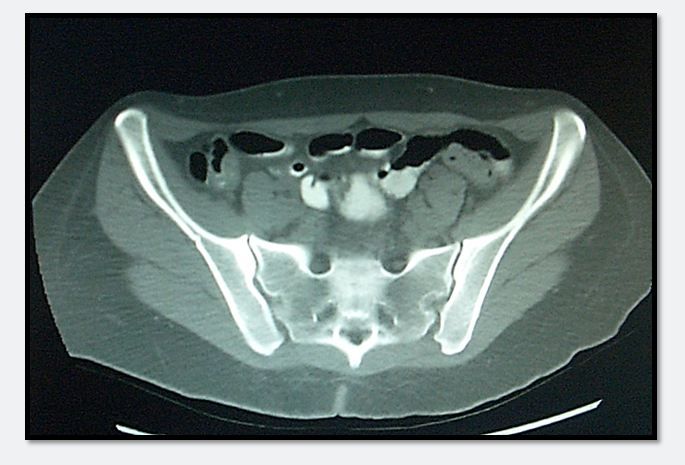Bloody Diarrhea in a Young Woman
Does the abdominal CT shown offer a clue to the cause of this repeat but markedly more severe episode of hematochezia?
Figure. CT scan abdomen; click to enlarge.

A 37-year-old woman presents to her local emergency department for 6 days of gradually worsening lower abdominal pain and diarrhea that has become progressively more bloody in the last 24 hours. She states that she has had a few similar episodes of this in the past that lasted 1-2 days where she never bothered to go to the doctor, but this time everything is significantly worse. She denies fever, vomiting, recent travel or recent antibiotics. She is otherwise healthy with no medical problems.
On physical exam, her vital signs are normal. Head and neck exam are unremarkable as are the heart and lungs. On her abdominal exam, she is tender in the right lower quadrant. Rectal exam shows a small amount of stool with a little gross blood. The rest of the exam is essentially normal.
Her urinalysis and pregnancy tests are normal and negative respectively. Her CBC shows a microcytic anemia with a hemoglobin of 9.1 g/dL and a white count that is elevated at 14.1. Liver enzymes and metabolic panel are both normal. A CT scan is ordered and shows mild colonic inflammation, especially in the area of the cecum, but a normal appendix. There is an additional clue on the image in the Figure above to the cause of the patient’s illness and whether it is infectious or inflammatory. Please click on image to enlarge.
What is the CT finding and what is its significance?
Clinical Tips for Using Antibiotics and Corticosteroids in IBD
January 5th 2013The goals of therapy for patients with inflammatory bowel disorder include inducing and maintaining a steroid-free remission, preventing and treating the complications of the disease, minimizing treatment toxicity, achieving mucosal healing, and enhancing quality of life.